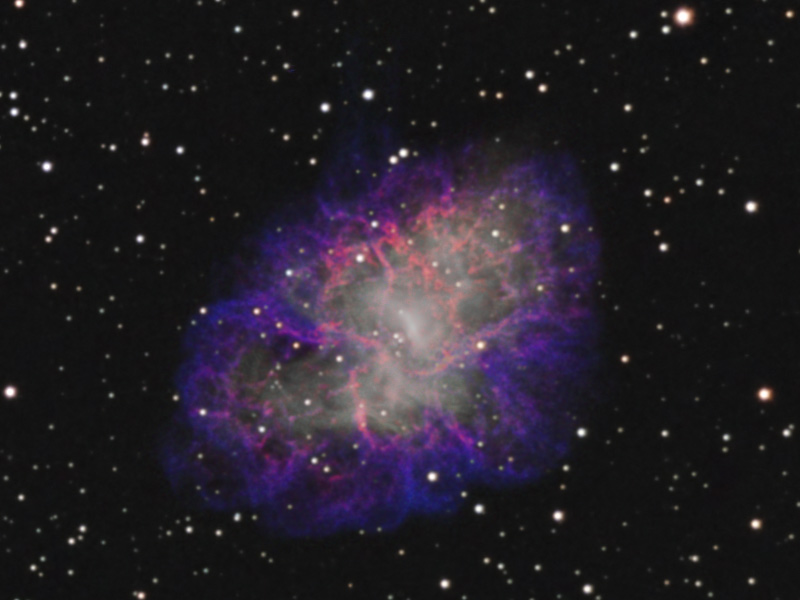it appears as though the pulsar wind is outstripping the filaments, especially mid lower left:

RGB only as my earlier images were limited.
a wider version shows a high proper motion star lower left.
Here’s is a composite of LRGB plus a touch of OIII luminance for the outer shell and faint jet up top as well as a 540x50nm filter for the pulsar wind (I finally switched to north up):

In year’s past, the pulsar wind appeared bluish, but this was using an LPR fliter which knocks out a chunk of the spectrum in green including the pulsar wind.
This year I used astrodon RGB filters without an LPR filter and excalibrator for color balance, so I think this is more “accurate”.
Yes, this is actually my first LRGB CCD image with RGB from a mono camera
what's the pulsar wind?
this:


I used a “green continuum” filter with a bandwidth of 50 nm centered at 540 nm which avoids the major emission lines of the crab nebula,
isolating the glowing pulsar wind caused by electrons accelerating in the rapidly rotating magnetic field of the spinning neutron star/pulsar.
the pulsar wind glow, rather than the central star, excites the gas filaments
which in turn give off the emission line signal.
Here’s the OIII:

Which gives a nicely defined outer shell, and a hint of the “jet” on top
Note that the upper right corner is a bit weak in OIII, the crab is stronger in broad band emissions there, not sure why.
And lastly here it is in red white and blue in honor of the date of the crab nebula supernova on July 4th:

Red is mapped to, um red, the continuum filter to white, and OIII to blue with an emphasis on the pulsar wind.
Maybe I can talk the APOD folks into posting it for July 4th
I captured the pulsar wind 2 years ago with a filter that had a narrower bandwidth and lower transmission, but failed to demonstrate any short term motion associated with the pulsar wind, which I caught with luminance in 2010.
Unfortunately, it was a bit of a fail as I was able to demonstrate very little if any motion with the new broader higher transmission continuum filter:

note slight expansion in the clear area around the central neutron star
The motion was a bit more evident on L/RGB than the continuum filter

(comparing 4 nights 2 luminance and 2 RGB pseudoluminance)
An analysis of the two RGB nights seemed to indicate the motion was better in the red channel, (subtle difference due to seeing/refraction?)
Not sure if that means it’s Ha/NII or red continuum…
Speaking of moving things I caught minor planet 541 Deborah (discovered by Max Wolf on August 4, 1904) on color images. The seeing was so bad (FWHM>7) that I actually threw the subs out.

found another moving object, very slow satellite or fast minor planet trailing in 10 minute subs at .8”/px:

at
05 34 32
22 01 00
on 2014 11 28 8:25:35 UT
MP checker indicates this is (2945) Zanstra
05 34 31.8 +22 01 00 16.4 0.0W 0.0S 33- 0+
a main-belt asteroid discovered on September 28, 1935 by H. van Gent
also see older posts:
http://astrowhw.blogspot.com/2013/07/4th-of-july-supernova-revisited-crab.html
http://astrowhw.blogspot.com/2013/07/crab-nebula-expansion.html
and this animation
2015
11/26/14-3/9/15
8" LX200R, SX Trius 694 and QSI 660 binned x2 to 0.8"/px, ASA DDM60
astrodon LRGB E SERIES GEN-II, OIII 5 nm, chroma 540x50 nm filter (greenish continuum)
L 346 x 1 min
red 33 x 4 min, green 22 x 4 min, blue 22 x 4 min (included as pseudoluminance)
OIII 24 x 20min
540x50 53 x 5min, 56 x 10min
2013
1/12/2013-3/4/2013
8" LX200R @ 0.6"/px, SX AO, Astrodon OIII 5nm, IDAS LPR filters SX H9/H9C
RGB(IDAS) 14x20 min, luminance 35x5 min with idas, 35x5 min unfiltered, plus RGB pseudoluminance
OIII 19x20 min
2010
12/6/2010-2/6/2011
8" LX200R, SX AO, Astrodon OIII 5nm IDAS LPR, SX H9/H9C
RGB 31x20 min, luminance 205x5 min plus RGB pseudoluminance, OIII 47x10 min binnned x2
2008
forgot the details there was too much star trailing for me to complete the initial processing.
aborted HaRGB
2006
1/2,3,5/06
nexstar 8 GPS, IDAS LPR filter, f/6.3 FR, SXV H9C
120x1 min, 240x30 sec (unguided)
No comments:
Post a Comment